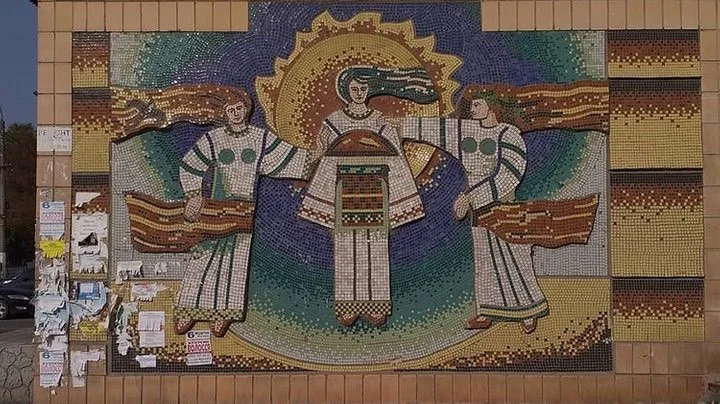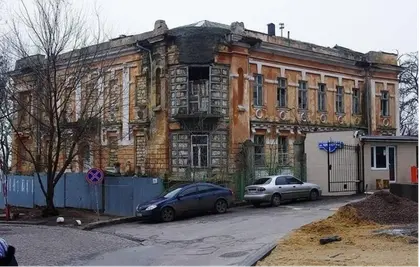Ukraine is publicly fighting to preserve its artistic heritage from the destruction of the war unleashed by Russia. In this just battle, Ukraine has found great support from UNESCO, which is mapping the sites affected by the bombings (churches, monuments, buildings), and many Western governments and foundations are offering generous contributions to restore of damaged cultural heritage.
Unfortunately, many cultural heritage sites are being destroyed by Ukrainians themselves. Here are two examples:
JOIN US ON TELEGRAM
Follow our coverage of the war on the @Kyivpost_official.
On June 30, 2023, an historic building in Odesa, constructed in 1903 by the architect Samuel Galperson, was demolished by bulldozers for an urgent work commissioned by Ukrainian owners. The building, which had been abandoned for years, was known as the Maternity Hospital No.6. Located in Shevchenko Park, it fell within the perimeter protected by UNESCO, according to the recent registration of the historic center of Odesa on the list of World Heritage sites. Furthermore, it had previously been included on the list of national architectural assets, which enjoy state protection. Nevertheless, no legal authority has prevented the workers from carrying out the demolition work.
Alexander Avdeev, head of the Office of State Control of Architecture of the Odesa City Council, confirmed that the building is part of the UNESCO World Heritage list, therefore protected by the state. He announced the convening of a commission to draw up an act to be sent to the State Inspectorate for Architecture and Town Planning and to the police.
On Aug. 23, 2022, a modernist mosaic that decorated the wall of a shop in the Kyiv suburb of Makariv, was dismantled with a jackhammer by Ukrainian workers, who were unaware of destroying a precious artwork. The Soviet-era object glorified the fertility of Ukraine’s lands and the hospitality of the Ukrainian people. It had survived the occupation by Russian troops in February 2022, which damaged 40 percent of the town’s buildings. But the mosaic had miraculously remained intact. The aftermath is visible on the Instagram page of “Ukrainian Modernism”:

Mosaic in Makariv
Dmytro Soloviov, founder of Ukrainian Modernism, a social media platform founded to catalogue and preserve Ukraine’s modernist heritage, wrote: “The monumental works that survived the war and occupation are becoming new symbols of the city, symbols of struggle and indomitability”
A memorial plaque with information about the mosaic and the liberation of Makariv was to be installed.
“We must preserve our culture and memory of the war, and not destroy them!” Soloviov added. “This is a crime against Ukrainian culture, against our artistic heritage. People who help the enemy destroy Ukrainian culture are collaborators and they should be punished.”
Ukrainian Modernism draws attention to other cases similar to Makariv. Soloviov has also called for creating a state register of important 20th-century Ukrainian monuments, artworks and architecture.
These two episodes are not isolated events. They bring up a serious problem facing the Ukrainian government: the poor law enforcement with respect to preventing the damage or destruction of national works of art and architecture in Ukraine and the lack of sanctions to deter these offences. There are many cases of Ukrainian citizens mobilized to save historical buildings before demolition, who have asked the police to stop the works, yet were not able to stop the bulldozers.
The laxness of Ukrainian authorities in protecting their artistic heritage causes serious damage to the country’s reputation.
First of all, it discredits the government’s ability to maintain international commitments such as the agreement signed with UNESCO for the historic center of Odesa.
Secondly, it discourages foreign governments and foundations that have generously provided funds for the preservation of Ukrainian cultural assets.
But above all, it spreads a negative image of a country that only cherishes a specific part of its history and culture, and this negative image will inevitably be exploited by enemy propaganda. It is a sour note in the important process of building Ukraine’s new national identity.
Some might object that in wartime there is no urgency to advocate for a more effective protection of cultural heritage. Yet when Winston Churchill was asked by the British cabinet to cut arts funding in favor of the war effort, he simply replied: “then what are we fighting for?”
The views expressed in this opinion article are the author’s and not necessarily those of Kyiv Post.
You can also highlight the text and press Ctrl + Enter



